
Eden was a local government district in Cumbria, England, based at Penrith Town Hall in Penrith. It was named after the River Eden, which flows north through the district toward Carlisle. Its population of 49,777 at the 2001 census, increased to 52,564 at the 2011 Census. A 2019 estimate was 53,253. In July 2021 it was announced that, in April 2023, Cumbria would be divided into two unitary authorities. On 1 April 2023, Eden District Council was abolished and its functions transferred to the new authority Westmorland and Furness, which also covers the former districts of Barrow-in-Furness and South Lakeland.

Hawes is a market town and civil parish in North Yorkshire, England, at the head of Wensleydale in the Yorkshire Dales, and historically in the North Riding of Yorkshire. The River Ure north of the town is a tourist attraction in the Yorkshire Dales National Park.

Barton is a village and civil parish in the Richmondshire district of North Yorkshire, England. According to the 2011 census it had a population of 837. It is situated near the border with the ceremonial county of County Durham, and is 6 miles south-west of Darlington.
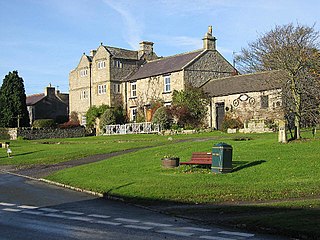
Bellerby is a village and civil parish in North Yorkshire, England, about 7 miles (11 km) south-west of Richmond. The village has one pub, the Cross Keys, a small and historic Anglican church and a Methodist chapel. It is 1.5 miles (2.4 km) from the market town of Leyburn. Bellerby is approximately 250 miles (400 km) north of London. Bellerby is situated 673 feet (205 m) above sea level and is surrounded by low-lying hills with an open south-easterly aspect. Moorland is located to the North and the West of the village. Becks are an attractive feature of the village, which boasts many. The residents of Bellerby are also proud of their large population of ducks who thrive in the becks and in the suitable gardens of many friendly residents. The closest big town is Leyburn.

Dalton is a village and civil parish in North Yorkshire in England. Dalton is situated about six miles north-west of Richmond and about five miles south-east of Barnard Castle within the council district of Richmondshire and close to the A66 trans-Pennine trunk road. It was listed in the Domesday book. The Dalton parish boundary includes the village itself as well the houses at Dalton Heights plus numerous surrounding farms. The population of the parish was 147 according to the 2001 census, increasing to 181 at the 2011 Census.

Manfield is a village and civil parish in the Richmondshire district of North Yorkshire, England. It is a parish in the wapentake of Gilling East. The closest major town is Darlington, which is 3.5 miles (5.6 km) east of Manfield. It is close to the River Tees and Darlington and is notable for its real ale pub, The Crown, which won the Campaign for Real Ale (CAMRA)'s Yorkshire Pub of the Year in 2005, the All Saints Church and Manfield Village School.

Cleasby is a village and civil parish in the North Yorkshire district of North Yorkshire, England. It is close to the River Tees and Darlington and the A1(M). The population at the 2011 Census of ONS was 208.

Newsham is a village and civil parish in the Richmondshire district of North Yorkshire, England. The village is 8 miles (13 km) north west of Richmond and 13 miles (21 km) south west of Darlington.
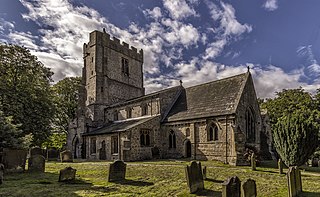
Kirby Hill, historically also known as Kirby-on-the-Hill, is a village and civil parish in the Richmondshire district of North Yorkshire, England. The village is about 1 mile (1.6 km) south of Ravensworth and about 4 miles (6 km) north-west of the town of Richmond.

Ravensworth is a village and civil parish in the Holmedale valley, within the Richmondshire district of North Yorkshire, England. It is approximately 4.5 miles (7.2 km) north-west of Richmond and 10 miles (16 km) from Darlington. The parish has a population of 255, according to the 2011 census.

Croft-on-Tees is a village and civil parish in the Richmondshire district of North Yorkshire, England. It has also been known as Croft Spa, and from which the former Croft Spa railway station took its name. It lies 11 miles (18 km) north-north west of the county town of Northallerton.
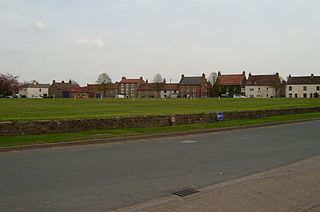
Scorton is a village and civil parish in the Richmondshire district of North Yorkshire, England. It is approximately 8 miles (13 km) north-west of the county town of Northallerton.

Hudswell is a village and civil parish on the border of the Yorkshire Dales, in North Yorkshire, England. The population at the ONS Census 2011 was 353.

Kirkby Fleetham is a village in the Hambleton District of North Yorkshire, England about 1 mile (1.6 km) east of the A1(M) road. Along with the two nearby villages of Great Fencote and Little Fencote it forms the civil parish of Kirkby Fleetham and Fencote. At the 2011 census, it was recorded as having a population of 560.
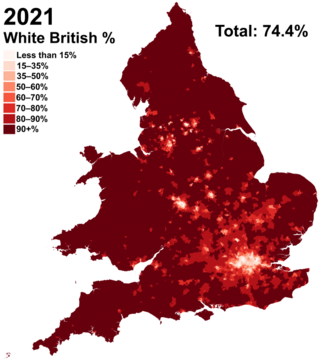
White British is an ethnicity classification used for the native white population identifying as English, Scottish, Welsh, Cornish, Northern Irish, or British in the United Kingdom Census. In the 2011 census, the White British population was 49,997,686, 81.5% of Great Britain's total population. For the United Kingdom entirely, due to different reporting measures within Northern Ireland which includes all those who identified as British with those who identified as Irish, an amalgamated total of 52,320,080 including those who identified as White Irish in Great Britain is given making up 82.8% of the population.

Great Heck is a small village in Heck parish, about 7 miles (11 km) south of Selby, North Yorkshire, England. The population of the parish was 201 at the 2011 census. It is part of the district of Selby, having been part of the West Riding of Yorkshire until 1974. The village was the site of the Great Heck rail crash in 2001.

Leathley is a village and civil parish in the Harrogate district of North Yorkshire, England, the parish includes the townships of both Castley and Leathley. It is near the border with West Yorkshire and the River Wharfe, 1 mile north-east of Otley. The B6161 runs through the village, connecting Leathley with Killinghall in the North and Pool-in-Wharfedale in the south.
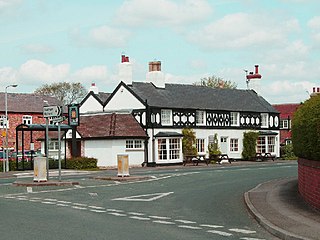
Long Marston is a village and civil parish in the Harrogate district of North Yorkshire, England. Historically part of the West Riding of Yorkshire, it is situated on the B1224 road from Wetherby to York, 7 miles (11 km) west of York. The civil parish includes the hamlets of Hutton Wandesley, immediately south of the village of Long Marston, and Angram, 1.5 miles (2.4 km) south east of Hutton Wandesley.

Harome is a small village and civil parish in the Ryedale district of North Yorkshire, England, around 2 miles (3.2 km) south-east of the market town of Helmsley, and 24 miles (39 km) north-east of York. The village has a population of 261 people according to the 2011 UK census, and a total land area of 9,539 sq metres. It is situated to the east of the River Riccal. The village has 109 households, with agriculture and retail trade being the two main employers for the residents. The name Harome simply means rocks/stones, and translates from old English meaning a heap of stones.

Sutton Weaver is a village and civil parish in the unitary authority of Cheshire West and Chester, in the ceremonial county of Cheshire, England. It is 2 miles (3.2 km) northeast of Frodsham and 2.5 miles south of Runcorn. According to the United Kingdom Census 2011, it had a population of 495 and a total land area of 3,198 sq metres (m2) (thousands). The village has 206 Households with some of the main industries of the village being Wholesale and Retail Trade, Human Health and Social Work Activities and Manufacturing; These three sectors alone account for 36.5% of Occupational Share.

























